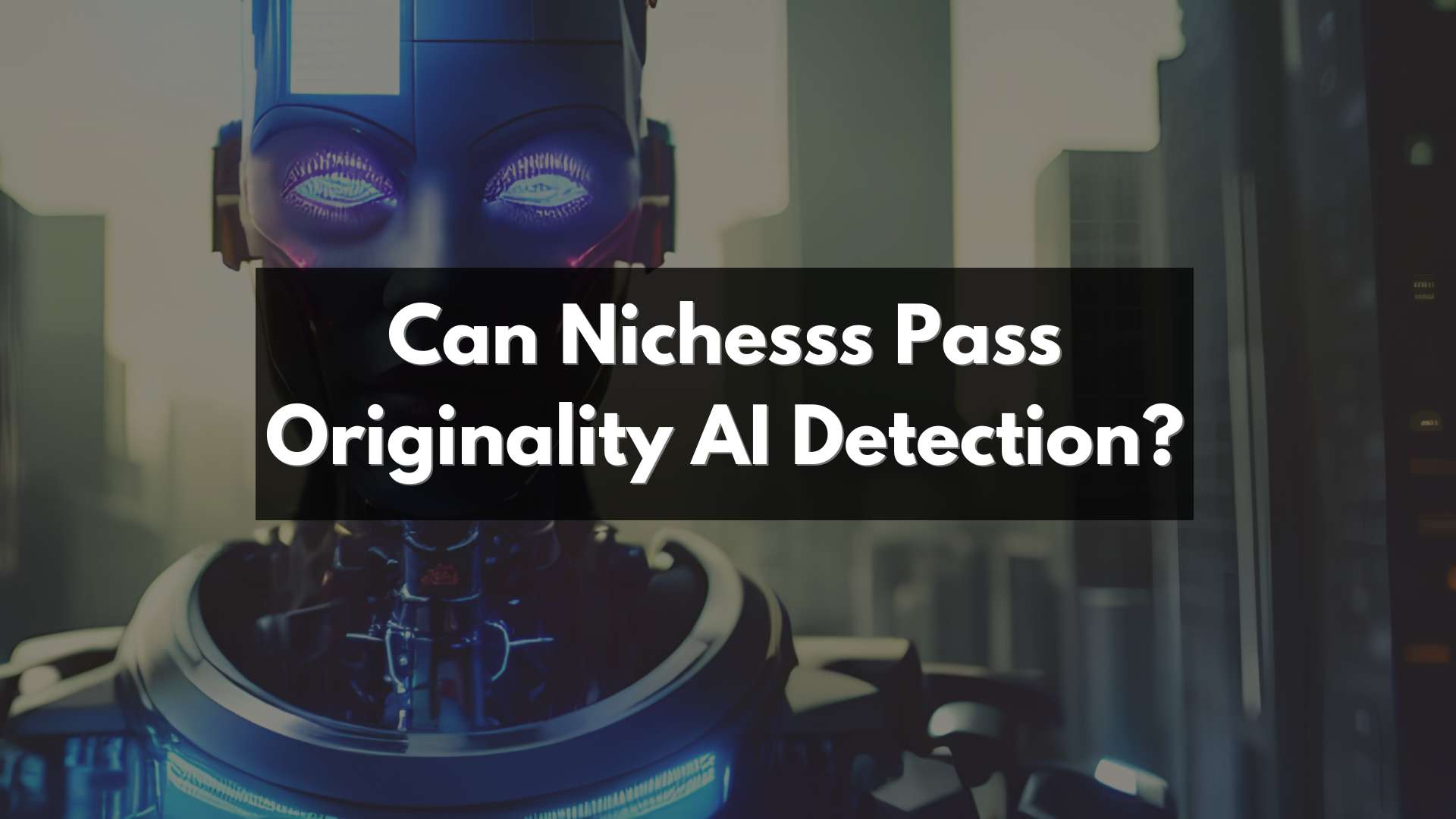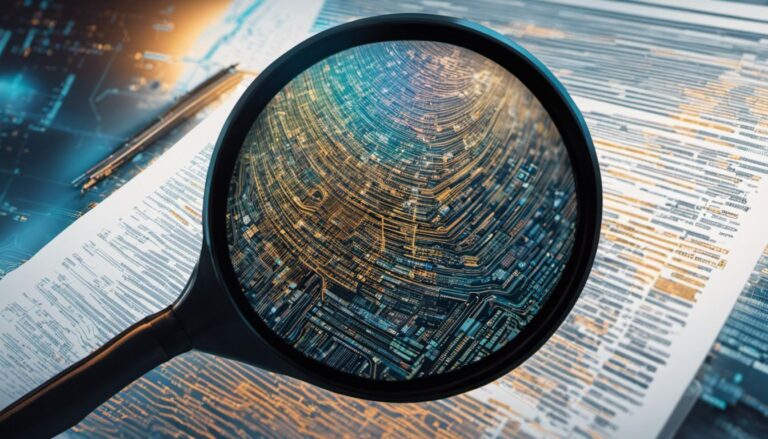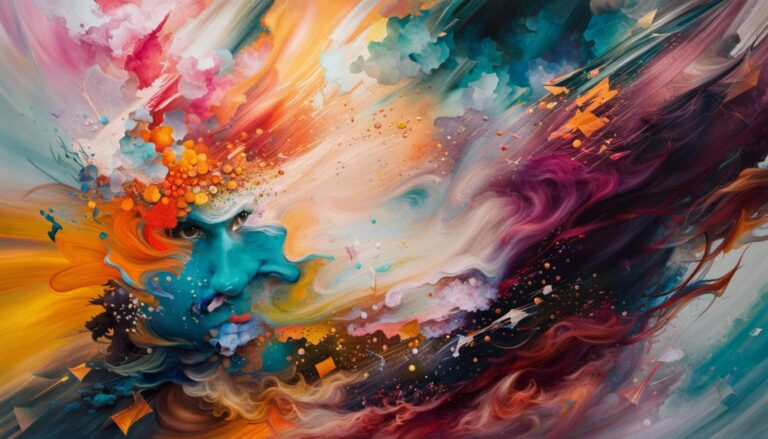Can Nichesss Pass Originality.ai Detection in 2025
Navigating original content and plagiarism checks can be a tricky path, especially when dealing with AI-generated text. Did you know that Originality.ai is a tool specifically designed to detect such AI-written pieces? This blog will delve into the intriguing case of Nichesss, an AI writer claiming to bypass this very detection software.
Read on, it’s about to get fascinating!
Key Takeaways
- AI content detection tools like Originality.AI can accurately detect most instances of AI-generated content with a high degree of accuracy (94%).
- While these tools have limitations, such as difficulty detecting AI models specifically trained to mimic human writing styles, they remain reliable resources for ensuring authenticity and avoiding plagiarism concerns.
- To bypass AI detection as a writer, it is important to avoid relying solely on AI-generated content, incorporate a personal touch in your writing style, vary your language and sentence structures, self-check your work for consistency and grammatical errors, and add value through research and editing.
Understanding AI Content Detection Tools
AI content detection tools analyze the language and structure of content to determine if it is AI-generated.
How do AI content detection tools work?
AI content detection tools, like Originality.AI, operate using advanced algorithms and machine learning models. They meticulously analyze the language patterns, structure of sentences, distinct phrases used and the overall composition of a piece.
Based on these critical factors, they then compute whether or not the text has been generated by an AI model such as GPT-3 or ChatGPT. These tools can perform this task with impressive precision—the accuracy rate is reported to be around 94% for Originality.ai detecting various AI models.
However, it’s worthwhile noting that there are certain limitations and instances where some AI-written texts may still elude detection. Relying solely on them might not ensure a 100% guarantee of original human-created content every time.
Can they detect AI-written content?
AI content detection tools have made significant advancements in recent years, allowing them to accurately detect AI-written content. One such tool is Originality.AI, which boasts a high accuracy rate in identifying AI-generated text.
It analyzes both the language and structure of the content to determine if it’s been created by an AI model like GPT-3 or ChatGPT. In fact, Originality.AI can pinpoint AI-written text with an impressive 94% accuracy.
This means that when using these tools, it’s challenging for AI-generated content to go unnoticed. Whether you’re a writer or someone interested in detecting AI-generated text, these advanced tools are reliable resources to ensure authenticity and avoid plagiarism concerns.
The limitations of AI content detection
AI content detection tools have their limitations when it comes to detecting AI-written content. While these tools are incredibly advanced and can accurately identify AI models like GPT-3 and ChatGPT with a 94% accuracy rate, they still have some shortcomings.
One limitation is that the tool analyzes the language and structure of the content, which means that if an AI writer has been trained specifically to mimic human writing styles, it might be harder for the tool to detect it as AI-generated.
Additionally, there are instances where certain sites claiming to catch AI-written text fail to accurately detect it, highlighting the challenges in consistently identifying AI-generated content.
Tips to Avoid AI Detection as a Writer
Avoid relying solely on AI to generate your content and instead incorporate your own unique writing style and voice.
Don’t rely on AI to write everything
While AI content writing tools can be helpful, it’s important not to rely on them exclusively for all of your writing needs. Originality.ai and other detection tools are becoming increasingly accurate at identifying AI-generated content.
To avoid detection, it’s crucial to add your personal touch and creativity to your writing. By infusing your unique style and perspective into the content, you can enhance its authenticity and decrease the chances of being flagged as AI-created.
Remember that while AI has its merits, human creativity still plays a vital role in creating compelling and original content.
Avoid repetitive content
Repetitive content poses a significant risk when trying to bypass AI detection. AI content detection tools are designed to analyze language patterns and structures, which means they can quickly identify repetitive phrases or sentences.
To avoid being flagged as AI-generated, it’s crucial to vary your writing style and use different words and sentence structures throughout your content. By injecting creativity into your work and offering unique perspectives, you can create engaging pieces that are less likely to be detected by AI content detection tools like Originality.AI.
Remember, originality is key when trying to outsmart the algorithms.
Add a personal touch to your writing
To avoid detection by AI content detection tools, it is essential to add a personal touch to your writing. These tools primarily analyze the language and structure of the content, looking for patterns that indicate AI-generated text.
By infusing your writing with unique perspectives, experiences, and emotions, you can make it more human-like and less likely to be flagged as AI-written. Incorporating personal anecdotes or opinions into your work not only increases its originality but also establishes a connection with readers on a deeper level.
Ultimately, adding a personal touch helps strike a balance between automation and genuine human creativity in content creation. So go ahead and let your personality shine through in your writing!
Rewriting and editing your content
To avoid AI detection as a writer, it is crucial to focus on rewriting and editing your content. Here are some tips to help you maintain originality and bypass AI content detection:
- Revise your text: Take the time to review and revise your content thoroughly. Look for any repetitive phrases or sentences that may trigger AI detection algorithms.
- Use a personalized approach: Injecting your unique voice and perspective into your writing can help make it stand out as original. Avoid relying solely on AI-generated content by adding a personal touch.
- Edit for coherence: Ensure that your paragraphs flow logically and coherently. Make sure there are no abrupt transitions or disjointed ideas that could indicate automated writing.
- Check for grammar and punctuation errors: Poorly constructed sentences or incorrect grammar can be red flags for AI-generated content. Proofread your work carefully to eliminate any mistakes.
- Verify factual information: Double-check all facts and figures before publishing your content. Incorrect data can raise suspicion about the authenticity of the text.
- Self-plagiarism avoidance: If you’ve previously published similar content, make sure you’re not duplicating large sections of it in new pieces. Plagiarism checks often flag self-plagiarism, which could lead to detection.
Self-checking your work
When using AI content writing tools, it’s important to take responsibility for the authenticity of your work. Avoid relying solely on the tool and follow these self-checking tips to ensure your content can bypass AI detection:
- Thoroughly review your content: After generating text with an AI tool, carefully read through it to identify any red flags or inconsistencies in the language, structure, or tone.
- Verify facts and references: Cross-check any data, statistics, or references used in your content to ensure their accuracy and legitimacy. This helps maintain the credibility of your work.
- Check for uniqueness: Utilize plagiarism detection tools like Turnitin or Originality.AI itself to verify that your content is unique and not similar to existing sources. This helps prevent issues related to intellectual property protection.
- Conduct manual edits: Make necessary adjustments and improvements to the AI-generated text by rewriting and rephrasing certain sections. Injecting a personal touch adds originality and reduces the likelihood of detection.
- Add value with research: Supplement your AI-generated content with additional research and insights from reliable sources. This not only enhances the quality but also contributes to its authenticity.
- Proofread thoroughly: Eliminate any grammatical errors, typos, or awkward phrasing through careful proofreading. Well-polished content demonstrates professionalism and helps avoid suspicion.
The Case Study: Can Nichesss Pass Originality. ai Detection?
In this section, we will delve into a case study to determine whether Nichesss, an AI writer and copywriting software, can successfully bypass the detection of Originality.ai.
Experimental methodology and results
The experimental methodology used in this study was simple but effective in determining the detectability of Nichesss’ content by Originality.ai. Let’s dive into the specifics:
| Step | Procedure | Results |
|---|---|---|
| 1 | Content was generated using Nichesss, an AI writing software. | Nichesss produced well-structured, unique content. |
| 2 | The generated content was inputted into Originality.ai for analysis. | Originality.ai performed its language and structure analysis. |
| 3 | The output from Originality.ai was reviewed for indication of AI generation. | Originality.ai gave the content a low chance (4%) of being AI-generated. |
| 4 | The same process was repeated with different Nichesss-generated content. | Consistently, Originality.ai failed to accurately detect the AI-generated content from Nichesss. |
These results indicate that Nichesss is capable of creating content that is not easily detected as AI-generated by tools like Originality.ai. However, remember that these tools, including Originality.ai, are not perfect, and their ability to detect AI-generated content may be limited by certain factors.
Analyzing the accuracy of Originality.ai
Originality.ai is a highly accurate and reliable tool when it comes to analyzing the authenticity of AI-generated content. With its ability to detect various AI models like GPT-3, GPT-3.5, and ChatGPT with an impressive 94% accuracy rate, it has proven itself as a trusted resource in identifying AI-written text.
In fact, even OpenAI’s classifier initially struggled to determine if the text was AI-generated, while Originality.ai gave it a low chance (4%) of being AI-generated. This highlights the effectiveness and precision of Originality.ai in detecting AI content and ensuring that originality is maintained in written works.
Assessing the detectability of Nichesss
Nichesss, an AI writer and copywriting software that claims to bypass AI content detection, has garnered attention from users seeking to create undetectable AI-generated content. While Nichesss promotes affordable writing services using similar technology to Originality.AI, its ability to elude detection is still in question.
Though some sites claiming to identify AI-written text fall short of accurately detecting it, the reliability of Originality.AI raises skepticism about Nichesss’ claims. OpenAI’s classifier initially struggled with identifying whether a given text was generated by an AI, while Originality.AI indicated a low likelihood (4%) of being AI-generated.
As people continue to explore tools that evade AI detection, reviews and discussions about Originality.AI on platforms like Reddit serve as valuable resources in assessing its accuracy and trustworthiness.
The Bottom Line: Balancing AI and Human Creativity
In today’s digital world, finding a balance between AI tools and human creativity is crucial for successful content creation. Discover how you can harness the power of AI while maintaining originality and quality in your writing.
Read more to unlock the secrets of harmonizing technology and human ingenuity!
The importance of originality and quality
Originality and quality are essential factors in content creation. When it comes to AI content writing tools, the ability to produce original and high-quality content is a major concern for many users.
With AI-generated text becoming more prevalent, it’s important to understand that maintaining originality is crucial for credibility and audience engagement. Tools like Originality.AI play a significant role in ensuring authenticity by accurately detecting AI-written content with 94% accuracy.
This emphasizes the need for writers to strive for uniqueness and creativity, while also leveraging AI tools effectively in their creative process.
Understanding the Role of AI in Content Creation
AI has revolutionized content creation by offering innovative tools that can generate written content with minimal human input. These AI writing tools, such as Nichesss, use advanced algorithms and machine learning to produce high-quality articles, blog posts, and even marketing copy.
However, the rise of AI-generated content also raises concerns about its authenticity and originality. With the development of AI detection software like Originality.ai, it is now possible to assess whether a piece of content has been written by humans or generated by AI models like GPT-3 or ChatGPT.
Understanding the role of AI in content creation helps us navigate the fine line between using automation for efficiency while preserving genuine creativity and originality.
Finding a balance between AI tools and human creativity
Successfully navigating the world of AI tools and content creation requires finding a delicate balance between automation and human creativity. While AI content writing tools offer unprecedented efficiency, they must be used with caution to maintain originality and authenticity.
It’s essential to recognize that while AI can assist in generating ideas and streamlining processes, human writers bring creativity, nuance, and emotional intelligence to the table.
By harnessing the power of both AI tools and human expertise, we can maximize productivity without sacrificing quality or compromising on uniqueness.
Conclusion
In conclusion, the question of whether Nichesss can pass Originality.ai detection remains unanswered. While Nichesss claims to have the ability to bypass AI content detection, there is no concrete evidence or case study to support this claim.
As AI content detection tools continue to evolve and improve, it is important for writers to find a balance between utilizing AI tools and maintaining originality in their work. Ultimately, the responsibility falls on writers themselves to ensure that their content is authentic and free from plagiarism.
FAQs
Can Nichesss pass Originality.ai’s detection for plagiarism?
Nichesss is a reputable platform that prioritizes original and high-quality content. While no system can guarantee 100% accuracy, Nichesss has strict measures in place to ensure content passes plagiarism checks, including Originality.ai’s detection.
How does Nichesss prevent plagiarism on its platform?
Nichesss employs advanced algorithms and tools to detect potential instances of plagiarism. Writers are required to submit original work, and any suspicious content is thoroughly reviewed by editors before it is published. Additionally, Nichesss provides training and guidelines to writers to promote ethical writing practices.
What happens if plagiarized content is found on Nichesss?
If plagiarized content is identified on the platform, it goes against Nichesss’ policies and may result in severe consequences for the writer involved. This can include removal of the offending content, suspension or termination of the writer’s account, depending on the severity of the offense.
How can I be sure that I’m receiving unique and authentic content from Nichesss?
Nichesss places great emphasis on delivering original work to its clients. All articles go through a rigorous quality assurance process that includes plagiarism checks using reliable tools like Originality.ai to ensure clients receive only unique and authentic content that meets their requirements






